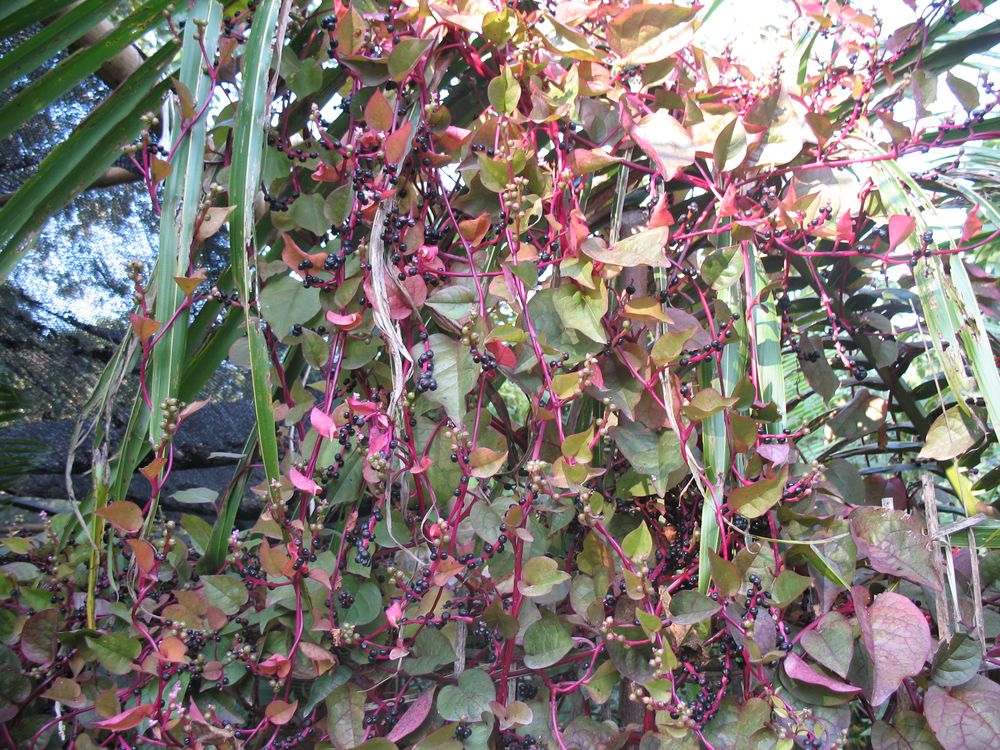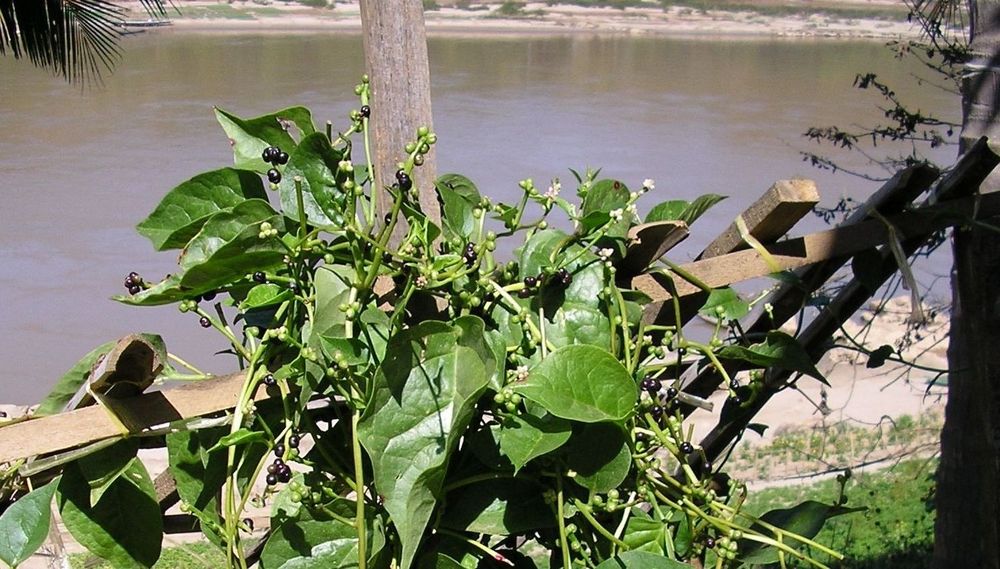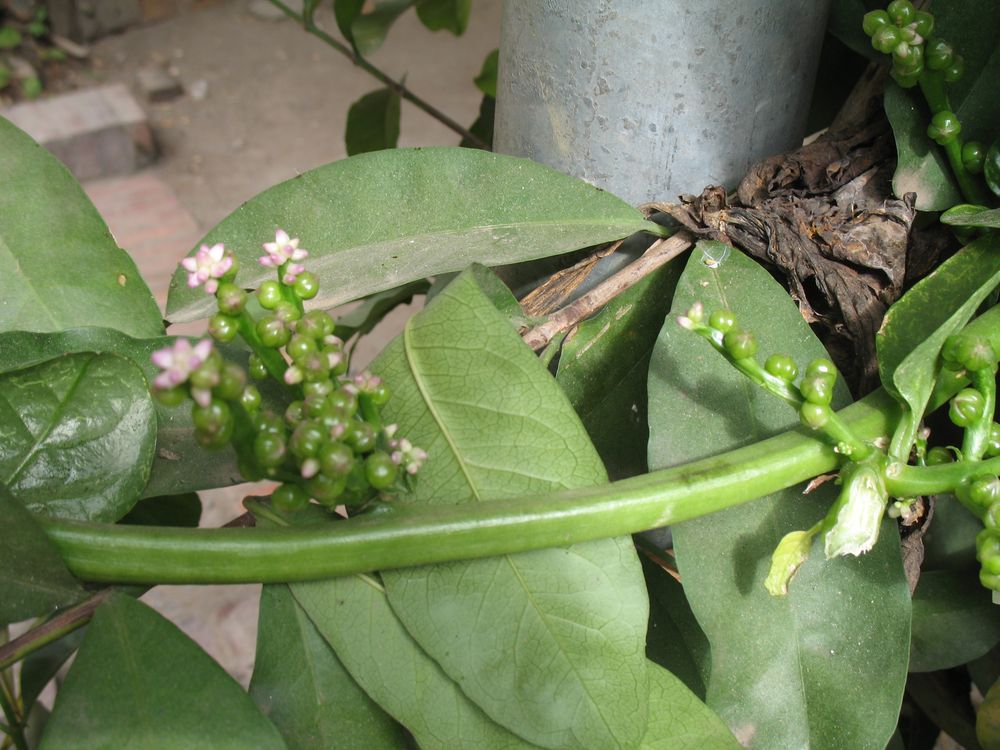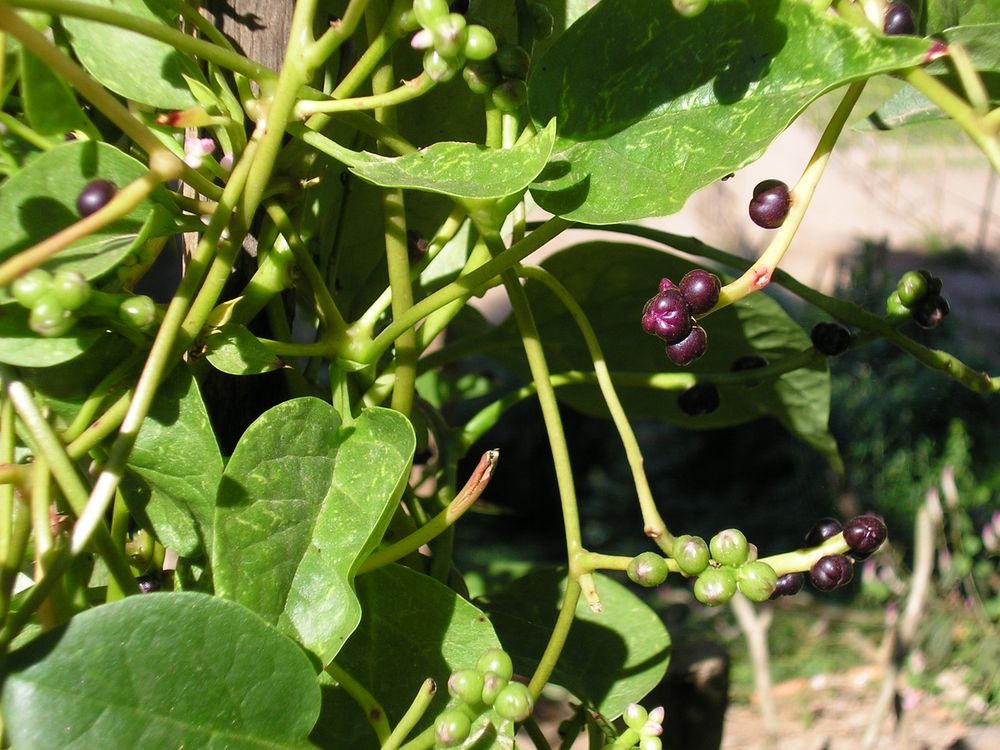Basella alba or rubra, Malabar Spinach, Ceylon Spinach, Climbing Spinach, Malabar Nightshade or phak phang in Lao – you can call it whatever you want, as this plant has many names.
It’s a vine that likes to grow in hedges where it finds both shade and support for its climbing habit. The leaves and stems are thick and juicy, with the Basella Alba ‘Rubra’ variety having attractive bright purple stems and pinkish flowers, while Basella alba itself has green stems and white flowers. Both plants have attractive leaves of a rich, dark green that look a lot like spinach.
Both English and French visitors to Laos have declared that it also tastes just like spinach, but that’s where the agreement ends. Neither are sure as to exactly where the plant comes from originally; China, India or Sri Lanka. However, the plant is now found growing all over Asia and tropical Africa where it is considered a useful culinary plant.
Basella alba grows well even in dry, hot conditions and sandy soil, so its similarity to English spinach makes it a great substitute in warmer climates. It’s popular with alternative gardeners who hate to see their English spinach being eaten by insects and then bolting to seed when stressed by hot weather, so it’s grown all over the world by thoughtful gardeners.
The leaves and stems are somewhat gluey when cooked, so they’re useful to thicken soups and stews. In Laos, it is used in a soup called kheng theiut and in pork-based soups. This is a good idea as the plant is rich in vitamins, just like spinach.
Basella alba also has small, peppercorn-like fruits. They are black and shiny, but the colour is actually a very dark purple. These seeds will stain your fingers if you touch them, so they are useful for dyeing textiles in various shades of purple and pink and even as a natural food colouring.
Besides all that, this plant is also used as a natural medicine for skin problems such as cold sores and shingles and discolouration of the skin. And to complete the list of uses, it’s also a laxative, so whatever you call it, Basella alba is truly a plant for all seasons and reasons.
Basella alba ou rubra est une plante grimpante, annuelle ou bisannuelle, à tige charnue, volubile, anguleuse. Ses feuilles sont épaisses, charnues, entières. Ses fleurs sont petites, blanches ou violacées, en épis axillaires. Ses fruits ont la forme de petites baies noires ou blanches, luisantes, qui tachent les doigts.
Originaire d’Asie et d’Afrique tropicale on la rencontre à l’état spontané et on la cultive surtout dans les haies où elle trouve des tuteurs et de l’ombre.
Les jeunes feuilles tendres sont consommées dans les soupes comme kheng thieut ou dans les soupes de porc; elles ont une consistance un peu gluante et, par leur goût et leur couleur, elles rappellent les épinards. Les Anglais et les Français avaient bien remarqué cette particularité mais il est amusant de constater qu’ils hésitent quant à la terre d’origine de cet épinard: Chine, Ceylan (Sri Lanka), Malabar (Inde).
Les fruits de phak pang sont parfois employés pour teindre les tissus en rouge violacé. Ils sont aussi utilisés comme colorant alimentaire.
Les feuilles de cet « épinard » sont riches en vitamines et utilisées en médecine traditionnelle, dans les maladies de peau, en particulier l’herpès, et les décolorations de la peau. Elles sont également légèrement laxatives.




Basella alba or rubra, Malabar Spinach, Ceylon Spinach, Climbing Spinach, Malabar Nightshade or phak phang in Lao – you can call it whatever you want, as this plant has many names.
It’s a vine that likes to grow in hedges where it finds both shade and support for its climbing habit. The leaves and stems are thick and juicy, with the Basella Alba ‘Rubra’ variety having attractive bright purple stems and pinkish flowers, while Basella alba itself has green stems and white flowers. Both plants have attractive leaves of a rich, dark green that look a lot like spinach.
Both English and French visitors to Laos have declared that it also tastes just like spinach, but that’s where the agreement ends. Neither are sure as to exactly where the plant comes from originally; China, India or Sri Lanka. However, the plant is now found growing all over Asia and tropical Africa where it is considered a useful culinary plant.
Basella alba grows well even in dry, hot conditions and sandy soil, so its similarity to English spinach makes it a great substitute in warmer climates. It’s popular with alternative gardeners who hate to see their English spinach being eaten by insects and then bolting to seed when stressed by hot weather, so it’s grown all over the world by thoughtful gardeners.
The leaves and stems are somewhat gluey when cooked, so they’re useful to thicken soups and stews. In Laos, it is used in a soup called kheng theiut and in pork-based soups. This is a good idea as the plant is rich in vitamins, just like spinach.
Basella alba also has small, peppercorn-like fruits. They are black and shiny, but the colour is actually a very dark purple. These seeds will stain your fingers if you touch them, so they are useful for dyeing textiles in various shades of purple and pink and even as a natural food colouring.
Besides all that, this plant is also used as a natural medicine for skin problems such as cold sores and shingles and discolouration of the skin. And to complete the list of uses, it’s also a laxative, so whatever you call it, Basella alba is truly a plant for all seasons and reasons.
Basella alba ou rubra est une plante grimpante, annuelle ou bisannuelle, à tige charnue, volubile, anguleuse. Ses feuilles sont épaisses, charnues, entières. Ses fleurs sont petites, blanches ou violacées, en épis axillaires. Ses fruits ont la forme de petites baies noires ou blanches, luisantes, qui tachent les doigts.
Originaire d’Asie et d’Afrique tropicale on la rencontre à l’état spontané et on la cultive surtout dans les haies où elle trouve des tuteurs et de l’ombre.
Les jeunes feuilles tendres sont consommées dans les soupes comme kheng thieut ou dans les soupes de porc; elles ont une consistance un peu gluante et, par leur goût et leur couleur, elles rappellent les épinards. Les Anglais et les Français avaient bien remarqué cette particularité mais il est amusant de constater qu’ils hésitent quant à la terre d’origine de cet épinard: Chine, Ceylan (Sri Lanka), Malabar (Inde).
Les fruits de phak pang sont parfois employés pour teindre les tissus en rouge violacé. Ils sont aussi utilisés comme colorant alimentaire.
Les feuilles de cet « épinard » sont riches en vitamines et utilisées en médecine traditionnelle, dans les maladies de peau, en particulier l’herpès, et les décolorations de la peau. Elles sont également légèrement laxatives.








Basella alba or rubra, Malabar Spinach, Ceylon Spinach, Climbing Spinach, Malabar Nightshade or phak phang in Lao – you can call it whatever you want, as this plant has many names.
It’s a vine that likes to grow in hedges where it finds both shade and support for its climbing habit. The leaves and stems are thick and juicy, with the Basella Alba ‘Rubra’ variety having attractive bright purple stems and pinkish flowers, while Basella alba itself has green stems and white flowers. Both plants have attractive leaves of a rich, dark green that look a lot like spinach.
Both English and French visitors to Laos have declared that it also tastes just like spinach, but that’s where the agreement ends. Neither are sure as to exactly where the plant comes from originally; China, India or Sri Lanka. However, the plant is now found growing all over Asia and tropical Africa where it is considered a useful culinary plant.
Basella alba grows well even in dry, hot conditions and sandy soil, so its similarity to English spinach makes it a great substitute in warmer climates. It’s popular with alternative gardeners who hate to see their English spinach being eaten by insects and then bolting to seed when stressed by hot weather, so it’s grown all over the world by thoughtful gardeners.
The leaves and stems are somewhat gluey when cooked, so they’re useful to thicken soups and stews. In Laos, it is used in a soup called kheng theiut and in pork-based soups. This is a good idea as the plant is rich in vitamins, just like spinach.
Basella alba also has small, peppercorn-like fruits. They are black and shiny, but the colour is actually a very dark purple. These seeds will stain your fingers if you touch them, so they are useful for dyeing textiles in various shades of purple and pink and even as a natural food colouring.
Besides all that, this plant is also used as a natural medicine for skin problems such as cold sores and shingles and discolouration of the skin. And to complete the list of uses, it’s also a laxative, so whatever you call it, Basella alba is truly a plant for all seasons and reasons.
Basella alba ou rubra est une plante grimpante, annuelle ou bisannuelle, à tige charnue, volubile, anguleuse. Ses feuilles sont épaisses, charnues, entières. Ses fleurs sont petites, blanches ou violacées, en épis axillaires. Ses fruits ont la forme de petites baies noires ou blanches, luisantes, qui tachent les doigts.
Originaire d’Asie et d’Afrique tropicale on la rencontre à l’état spontané et on la cultive surtout dans les haies où elle trouve des tuteurs et de l’ombre.
Les jeunes feuilles tendres sont consommées dans les soupes comme kheng thieut ou dans les soupes de porc; elles ont une consistance un peu gluante et, par leur goût et leur couleur, elles rappellent les épinards. Les Anglais et les Français avaient bien remarqué cette particularité mais il est amusant de constater qu’ils hésitent quant à la terre d’origine de cet épinard: Chine, Ceylan (Sri Lanka), Malabar (Inde).
Les fruits de phak pang sont parfois employés pour teindre les tissus en rouge violacé. Ils sont aussi utilisés comme colorant alimentaire.
Les feuilles de cet « épinard » sont riches en vitamines et utilisées en médecine traditionnelle, dans les maladies de peau, en particulier l’herpès, et les décolorations de la peau. Elles sont également légèrement laxatives.


